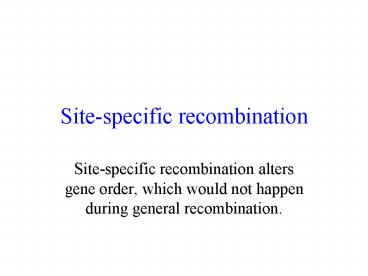Site-specific recombination PowerPoint PPT Presentation
1 / 25
Title: Site-specific recombination
1
Site-specific recombination
- Site-specific recombination alters gene order,
which would not happen during general
recombination.
2
Site-specific recombination
- Site-specific recombination moves specialized
nucleotide sequences (mobile genetic elements)
between nonhomologous sites within a genome. - All types of mobile genetic elements occasionally
move or rearrange neighboring DNA sequences of
the host cell genome.
3
Site-specific recombination
- The relics of site-specific recombination
(repeated DNA sequences) can be found in many
vertebrate chromosomes (45 in human). - The translocation of mobile genetic elements
gives rise to spontaneous mutations in organisms.
4
Site-specific recombination
- Site-specific recombination is guided by
recombination enzymes that recognize short,
specific nucleotide sequences present on one or
both of the recombining DNA molecules.
5
There are two types of site-specific recombination
- Transpositional site-specific recombination does
not involve the formation of heteroduplex DNA
between mobile DNA segments and its host, so a
short homologous sequence is not required. - Conservative site-specific recombination requires
the formation of heteroduplex DNA so a short
homologous sequence is required.
6
Transpositional site-specific recombination
- Most transposons move only very rarely (10-5)
7
Three types of transposons
8
DNA-only transposon
- DNA-only transposons exist as DNA throughout its
life cycle. The translocating DNA segment is
directly cut out of the donor DNA and joined to
the target site by a transposase.
9
DNA-only transposons cut-and-paste transposition
(dimer)
NHEJ or HEJ
Because staggered breaks were generated during
insertion
10
Some DNA-only transposons use replicative
transposition, a variation of the cut-and-paste
mechanism
11
Retroviral-like retrotransposons
- Retrovirus and retroviral-like retrotransposons
use the same mechanism to move themselves.
12
The propagation of retroviral-like
retrotransposons
transcription
13
Integrase made the integration of retroviral-like
retrotransposons
14
Nonretroviral retrotransposons
- The RNA and reverse transcriptase have a much
direct role in the recombination event for
nonretroviral retrotransposons.
15
Nonretroviral retrotransposons
- Nonretroviral retrotransposons left large number
of repeated sequences in human genome. These
repeats are mostly mutated and truncated so they
cannot transpose anymore. - L1 element (LINE, long interspersed nuclear
element) belongs to this group. It carries its
own reverse transcriptase and endonuclease.
16
The transposition of nonretroviral
retrotransposons
(this part is not fully understood yet)
17
Nonretroviral retrotransposons
- Other nonretroviral retrotransposons like Alu
element lacks reverse transcriptase or
endonuclease can still propagate themselves by
using those enzymes from host or other
nonretroviral retrotransposons.
18
(No Transcript)
19
Genomes of eukaryotic organisms are littered with
relics of transposons
20
Genomes of eukaryotic organisms are littered with
relics of transposons
- In human, DNA-only and retroviral-like
transposons have been inactive in the human
lineage since very long ago. In contrast, some of
the nonretroviral retrotransposons are still
moving (2). - In mouse, both types of retrotransposons are
still moving and are responsible for 10 percent
of new mutations.
21
Conservative site-specific recombination
- The best example of the conservative
site-specific recombination is bacteriophage
lambda.
22
(No Transcript)
23
Because integrase remained bound with DNA just
like topoisomerase, the action of lambda
integrase does not require ATP.
24
(No Transcript)
25
excisionase

